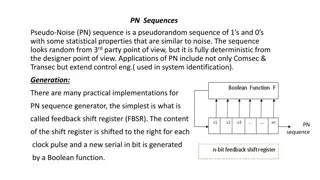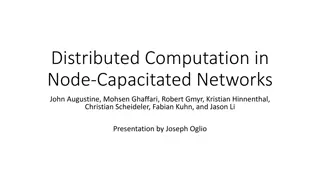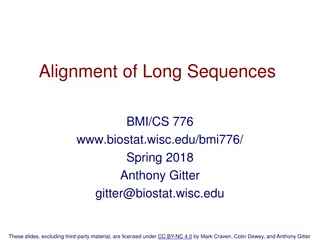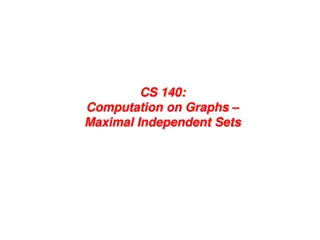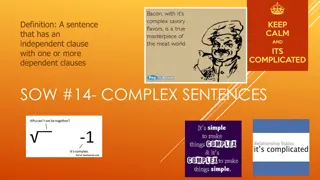Maximal Independent Set
Maximal Independent Sets (MIS) in graph theory play a crucial role in network topology control and monitoring. MIS are sets of nodes that are not adjacent, defining parallel processing capabilities and interference-free communication. While finding minimum or maximum MIS is NP-hard, their applications in processor partitioning and network monitoring are significant. Explore the concept of MIS and its impact on network operations.
Download Presentation

Please find below an Image/Link to download the presentation.
The content on the website is provided AS IS for your information and personal use only. It may not be sold, licensed, or shared on other websites without obtaining consent from the author.If you encounter any issues during the download, it is possible that the publisher has removed the file from their server.
You are allowed to download the files provided on this website for personal or commercial use, subject to the condition that they are used lawfully. All files are the property of their respective owners.
The content on the website is provided AS IS for your information and personal use only. It may not be sold, licensed, or shared on other websites without obtaining consent from the author.
E N D
Presentation Transcript
Independent (or stable) Set (IS): In a graph G=(V,E), |V|=n, |E|=m, any set of nodes that are not adjacent 2
Maximal Independent Set (MIS): An independent set that is no subset of any other independent set 3
Size of Maximal Independent Sets a MIS of minimum size a MIS of maximum size (a.k.a. maximum independent set) A graph G Remark 1: The ratio between the size of a maximum MIS and a minimum MIS is unbounded (i.e., O(n))! Remark 2: Depending on the application, we might be interested in finding a MIS of either small or large size, but unfortunately finding a minimum/maximum MIS is an NP-hard problem since deciding whether a graph has a MIS of size k is NP-complete Remark 3: On the other hand, a MIS can be found in polynomial time 4
Applications in DS: network topology control In a network graph consisting of nodes representing processors, a MIS defines a set of processors which can operate in parallel without interference For instance, in wireless ad hoc networks, to avoid interferences, a conflict graph (based on the overlapping in the transmission ranges) is built, and a MIS of such a graph defines a partition of the nodes enabling interference-free communication, where messages are broadcasted by the nodes in the MIS to their neighbors (in such an application, to reduce the congestion at the MIS nodes, one should find a MIS of maximum size, but as said before this is known to be NP-hard) 5
Applications in DS: network monitoring A MIS is also a Dominating Set (DS) of the graph (the converse in not true, unless the DS is independent), namely every node in G is at distance at most 1 from at least one node in the MIS (otherwise the MIS could be enlarged, against the assumption of maximality!) In a network graph G consisting of nodes representing processors, a MIS defines a set of processors which can monitor the correct functioning of all the nodes in G: each node in the MIS will ping continuously its neighbors (in such an application, one should find a MIS of minimum size, to minimize the number of sentinels, but as said before this is known to be NP-hard) Question: Exhibit a graph G s.t. the ratio between a Minimum MIS and a Minimum Dominating Set is (n), where n is the number of vertices of G. 6
A sequential algorithm to find a MIS Suppose that I will hold the final MIS, and assume that we are not interested in any respect to the final size of the MIS = I G Initially 7
Phase 1: 1v Pick an arbitrary (i.e., at random) node and add it to I 1v G = G 1 8
Identify the neighborhood of v1, say N(v1) 1v G 1 N (1v ) 9
Remove v1 and N(v1), and let G2 be the resulting graph G 2 10
Phase 2: v Pick at random a node and add it to I 2 G 2 v 2 11
v N (2 v ) Identify and neighbors 2 G 2 v 2 N (2 v ) 12
Remove v2 and N(v2), and let G3 be the resulting graph G 3 13
Phases 3,4,5,: Repeat until all nodes are removed G 3 14
Phases 3,4,5,,x: Repeat until all nodes are removed G x 1 + No remaining nodes 15
G At the end, set will be a MIS of I G 16
Analysis Let G=(V,E) and n=|V| and m=|E|. If the algorithm is implemented in a centralized setting, then its running time is (m). On the other hand, the number of phases of the algorithm is equal to the size of the found MIS, and clearly it is O(n). Worst case graph (for number of phases): n nodes, n-1 phases 17
Question Can you see a distributed version of the just given algorithm? Yes, we can elect a leader at each phase, and then add it to the MIS. In this distributed version, we would like to minimize the number of phases, since in this way the number of leader elections will be minimized! But actually, we can avoid these LE steps, as explained in the following 18
A Generalized Algorithm For Computing a MIS Same as the previous algorithm, but at each phase, instead of a single node, we now select any independent set (this selection should be seen as a black box at this stage, i.e., we do not know/specify how such independent set is selected) The underlying idea is that this approach will be useful for a distributed algorithm, since it will reduce the number of phases 19
Example: Suppose that will hold the final MIS I Initially = I G 20
Phase 1: Find any independent set and add to : 1I I I 1I 1I I G = G 1 21
Remove I1 and N(I1), and let G2 be the resulting graph G 2 23
Phase 2: On new graph Find any independent set I and add to : I 2 I I I I 2 2 G 2 24
Remove I2 and N(I2), and let G3 be the resulting graph G 3 26
Phase 3: On new graph Find any independent set I and add to : I 3 I I I I 3 3 G 3 27
Remove I3 and N(I3), and let G4 be the resulting graph G 4 No nodes are left, termination 29
Final MIS I G 30
Analysis 1. The algorithm is correct, since independence and maximality follow by construction 2. Running time is now (m) (the time needed to remove the edges), plus the time needed at each phase to find an independent set (this is really the crucial step!) 3. The number of phases now depends on the choice of the independent set in each phase: The larger the subgraph removed at the end of a phase, the smaller the residual graph, and then the faster the algorithm. Then, how do we choose such a set, so that independence is guaranteed and the convergence is fast? 31
1I Example: If is a MIS, one phase is enough! I Example: If each contains one node, phases may be needed ) (n k (sequential algorithm) 32
Selecting an IS An idea could be the following: at each phase, pick an arbitrary set of k nodes, remove from it adjacent nodes, and then add all the remaining nodes to the solution; Question: how do we select k? Good point, if k is too large, one may be forced to remove many adjacent nodes during the execution Remark: given a pair of adjacent nodes, instead of removing both, just remove one of them: indeed, this potentially enlarge the size of the set of nodes added to the solution, thus reducing the number of phases 33
A Randomized Synchronous Distributed Algorithm Implements in a distributed setting the latter MIS algorithm, by choosing randomly at each phase the independent set, in such a way that it is expected to remove many nodes from the current residual graph Works with synchronous (not really necessary!), uniform models, and does not make use of the processor IDs Remark: It is randomized in a Las Vegas sense, i.e., it uses randomization only to reduce the expected running time, but always terminates with a correct result (against a Monte Carlo sense, in which the running time is fixed, while the result is correct with a certain probability) 34
Let >1 be the maximum node degree in the whole graph G 2 1 Suppose that is known to all the nodes (this may require a pre-processing) 35
k In the first round of a phase : z G Each node elects itself with probability p=1/ k 2 y 1 z Elected nodes are candidates for independent set I k 36
However, it is possible that neighbor nodes are elected simultaneously (nodes can check it out by notifying their election to their neighborhood ) G Problematic nodes k 37
All the problematic nodes step back to the unelected status, and proceed to the next phase. The remaining elected nodes form independent set Ik, and Gk+1 = Gk\ (Ik U N(Ik)) G G+ k I k k 1 I k I I k k 38
Analysis: z G Success for a node in phase : disappears at the end of phase (enters or ) k k k z k I N ( I ) k A good scenario that guarantees success for z and all of its neighbors No neighbor elects itself 2 y 1 z elects itself 39
Basics of Probability Let A and B denote two events in a probability space; let 1. A (i.e., not A) be the event that A does not occur; 2. A B be the event that both A and B occur; 3. AUBbe the event that A or (non-exclusive) B occurs. Then, we have that: 1. P( A)=1-P(A); 2. if A and B are independent, then P(A B)=P(A) P(B) Example: if two coins are flipped the chance of both being heads is = 3. if A and B are mutually exclusive, then P(AUB)=P(A)+P(B), otherwise P(AUB)=P(A)+P(B)-P(A B) Example: the chance of rolling a 1 or 2 on a six-sided dice is 1/6+1/6=1/3 (mutual exclusion), while the chance of rolling a value 3 or an even value is 1/2 +1/2 - 1/6 = 5/6 (the two events are not mutually exclusive, since if 2 is rolled, then both events are verified, so we have to subtract the probabilty 1/6 that 2 is rolled) 40
Fundamental inequality x | x 1, x, 2,7182... e = | x t t 2 + e 1 1 e t t t t x x 41
Probability for a node z of success in a phase: P(success z) = P((z enters Ik) OR (z enters N(Ik))) P(z enters Ik) i.e., it is at least the probability that it elects itself AND no neighbor elects itself, and since these events are independent, if y=|N(z)|, then P(z enters Ik) = p (1-p)y (recall that p=1/ ) 1 p No neighbor elects itself 1 p 1 p 2 y 1 z p elects itself 42
Probability of success for a node in a phase: ( ) p 1 p At least y p(1 p) d d 1 1 1 = d d Fundamental inequality 1 1 x 1 t t 2 + e 1 1 t ed d x x with t=-1 and x= 1: (1-1/ ) (1-(-1)2/ )e(-1) i.e., (1-1/ ) 1/e (1-1/ ) 1 for 2 2ed 43
z Therefore, node disappears at the end of a phase with probability at least 1 ed 2 2 y 1 z Node z does not disappear at the end of a phase with probability at most 1 1 2ed 44
z Definition: Bad event for node : after phases ed ln 4 node did not disappear z n Independent events This happens with probability P(ANDk=1,..,4ed lnn (z does not disappear at the end of phase k)) i.e.,at most: 2 ln n ed ed 4 ln n 2 1 ed 1 ed 1 1 1 1 = = 2 2 n e 2 2 ln n (fund. ineq. (1+t/x)x et with t =-1 and x =2e ) 45
Definition: Bad event for graph G: ed ln 4 n after phases at least one node did not disappear (i.e., computation has not yet finished) This happens with probability (notice that events are notmutually exclusive, since several nodes may not disappear): P(ORz G(bad event for z)) 1 1 P(bad event for ) 2= z n n n z G 46
Definition: Good event for graph G: ed ln 4 n within phases all nodes disappear (i.e., computation has finished) This happens with probability: 1 1 [probabili ty of bad event for G] 1 - n (i.e., with high probability (w.h.p.), since it goes to 1 as n goes to infinity) 47
Time complexity Total number of phases: 4 # rounds for each phase: 3 1. In round 1, each node adjusts its neighborhood (according to round 3 of the previous phase), and then elects itself with probability 1/ ; if this is the case, it notifies its neighbors; 2. In round 2, each node receives notifications of election from its neighbors (if any), decide whether it is in Ik, and if this is the case, it notifies its neighbors, and stops; 3. In round 3, each node receiving notifications from elected neighbors, realizes to be in N(Ik), notifies its neighbors about that, and stops. total # of rounds: (w.h.p.) d ed ln n O ( log n ) (w.h.p.) = O ( d log n ) 48
Homework Can you provide a good bound on the total number of messages? Can you see an asynchronous version of the algorithm? 49




